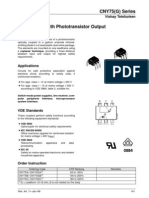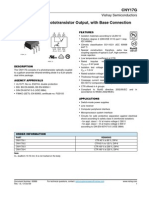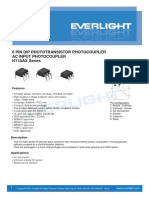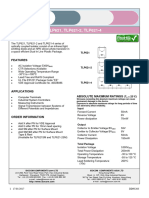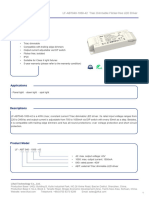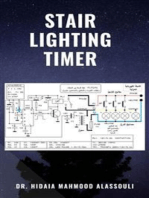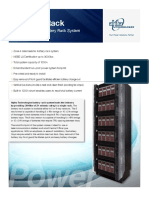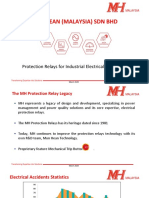Tcet110 - Tcet2100 Tcet4100 PDF
Tcet110 - Tcet2100 Tcet4100 PDF
Uploaded by
Marcio ShiinoCopyright:
Available Formats
Tcet110 - Tcet2100 Tcet4100 PDF
Tcet110 - Tcet2100 Tcet4100 PDF
Uploaded by
Marcio ShiinoOriginal Title
Copyright
Available Formats
Share this document
Did you find this document useful?
Is this content inappropriate?
Copyright:
Available Formats
Tcet110 - Tcet2100 Tcet4100 PDF
Tcet110 - Tcet2100 Tcet4100 PDF
Uploaded by
Marcio ShiinoCopyright:
Available Formats
TCET110.
(G) up to TCET4100
Vishay Telefunken
Optocoupler with Phototransistor Output
Description
The TCET110./ TCET2100/ TCET4100 consists of a
phototransistor optically coupled to a gallium arsenide
infrared-emitting diode in a 4-lead up to 16-lead plastic
dual inline package.
The elements are mounted on one leadframe using a
coplanar technique, providing a fixed distance be-
tween input and output for highest safety
requirements.
Applications
Circuits for safe protective separation against electri-
cal shock according to safety class II (reinforced 14925
isolation):
D For appl. class I – IV at mains voltage ≤ 300 V
D For appl. class I – III at mains voltage ≤ 600 V
according to VDE 0884, table 2, suitable for:
Coll. Emitter
Switch-mode power supplies, line receiver, com-
puter peripheral interface, microprocessor
system interface.
13929
VDE Standards
These couplers perform safety functions according to Anode Cath.
the following equipment standards: 4 PIN
D VDE 0884 8 PIN
Optocoupler for electrical safety requirements 16 PIN
D IEC 950/EN 60950
Office machines (applied for reinforced isolation
for mains voltage ≤ 400 VRMS)
D VDE 0804
Telecommunication apparatus and data
processing
D IEC 65
C
Safety for mains-operated electronic and related
household apparatus
Document Number 83503 www.vishay.de • FaxBack +1-408-970-5600
Rev. A6, 08–Sep–99 1 (11)
TCET110.(G) up to TCET4100
Vishay Telefunken
Order Instruction
Ordering Code CTR Ranking Remarks
TCET1100/ TCET1100G1) 50 to 600% 4 Pin = Single channel
TCET1101/ TCET1101G1) 40 to 80% 4 Pin = Single channel
TCET1102/ TCET1102G 1) 63 to 125% 4 Pin = Single channel
TCET1103/ TCET1103G1) 100 to 200% 4 Pin = Single channel
TCET1104/ TCET1104G1) 160 to 320% 4 Pin = Single channel
TCET1105/ TCET1105G 1) 50 to 150% 4 Pin = Single channel
TCET1106/ TCET1106G1) 100 to 300% 4 Pin = Single channel
TCET1107/ TCET1107G1) 80 to 160% 4 Pin = Single channel
TCET1108/ TCET1108G 1) 130 to 260% 4 Pin = Single channel
TCET1109/ TCET1109G1) 200 to 400% 4 Pin = Single channel
TCET2100 50 to 600% 8 Pin = Dual channel
TCET4100 50 to 600% 16 Pin = Quad channel
1) G = Leadform 10.16 mm; G is not marked on the body
Features
Approvals: D Creepage current resistance according
to VDE 0303/IEC 112
D BSI: BS EN 41003, BS EN 60095 (BS 415), Comparative Tracking Index: CTI ≥ 175
BS EN 60950 (BS 7002),
Certificate number 7081 and 7402 D Thickness through insulation ≥ 0.75 mm
D FIMKO (SETI): EN 60950, D Internal creepage distance > 4 mm
Certificate number 11027
General features:
D Underwriters Laboratory (UL) 1577 recognized,
file number E-76222 – Double Protection D CTR offered in 9 groups
D CSA (C-UL) 1577 recognized D Isolation materials according to UL94-VO
file number E- 76222 - Double Protection
D Pollution degree 2
D VDE 0884, Certificate number 115667 (DIN/VDE 0110 / resp. IEC 664)
D Climatic classification 55/100/21 (IEC 68 part 1)
VDE 0884 related features:
D Special construction:
D Rated impulse voltage (transient overvoltage) Therefore, extra low coupling capacity of
VIOTM = 8 kV peak typical 0.2 pF, high Common Mode Rejection
D Isolation test voltage D Low temperature coefficient of CTR
(partial discharge test voltage) Vpd = 1.6 kV D G = Leadform 10.16 mm;
D Rated isolation voltage (RMS includes DC) provides creepage distance > 8 mm,
VIOWM = 600 VRMS (848 V peak) for TCET2100/ TCET4100 optional;
D Rated recurring peak voltage (repetitive) suffix letter ‘G’ is not marked on the optocoupler
VIORM = 600 VRMS D Coupling System U
www.vishay.de • FaxBack +1-408-970-5600 Document Number 83503
2 (11) Rev. A6, 08–Sep–99
TCET110.(G) up to TCET4100
Vishay Telefunken
Absolute Maximum Ratings
Input (Emitter)
Parameter Test Conditions Symbol Value Unit
Reverse voltage VR 6 V
Forward current IF 60 mA
Forward surge current tp ≤ 10 ms IFSM 1.5 A
Power dissipation Tamb ≤ 25°C PV 100 mW
Junction temperature Tj 125 °C
Output (Detector)
Parameter Test Conditions Symbol Value Unit
Collector emitter voltage VCEO 70 V
Emitter collector voltage VECO 7 V
Collector current IC 50 mA
Collector peak current tp/T = 0.5, tp ≤ 10 ms ICM 100 mA
Power dissipation Tamb ≤ 25°C PV 150 mW
Junction temperature Tj 125 °C
Coupler
Parameter Test Conditions Symbol Value Unit
Isolation test voltage (RMS) t = 1 min VIO 5 kV
Total power dissipation Tamb ≤ 25°C Ptot 250 mW
Operating ambient temperature Tamb –40 to +100 °C
range
Storage temperature range Tstg –55 to +125 °C
Soldering temperature 2 mm from case t ≤ 10 s Tsd 260 °C
Document Number 83503 www.vishay.de • FaxBack +1-408-970-5600
Rev. A6, 08–Sep–99 3 (11)
TCET110.(G) up to TCET4100
Vishay Telefunken
Electrical Characteristics (Tamb = 25°C)
Input (Emitter)
Parameter Test Conditions Symbol Min. Typ. Max. Unit
Forward voltage IF = ± 50 mA VF 1.25 1.6 V
Junction capacitance VR = 0 V, f = 1 MHz Cj 50 pF
Output (Detector)
Parameter Test Conditions Symbol Min. Typ. Max. Unit
Collector emitter voltage IC = 1 mA VCEO 70 V
Emitter collector voltage IE = 100 mA VECO 7 V
Collector emitter cut-off VCE = 20 V, If = 0, E = 0 ICEO 10 100 nA
current
Coupler
Parameter Test Conditions Symbol Min. Typ. Max. Unit
Collector emitter IF = 10 mA, IC = 1 mA VCEsat 0.3 V
saturation voltage
Cut-off frequency VCE = 5 V, IF = 10 mA, fc 110 kHz
RL = 100 W
Coupling capacitance f = 1 MHz Ck 0.3 pF
Current Transfer Ratio (CTR)
Parameter Test Conditions Type Symbol Min. Typ. Max. Unit
IC/IF VCE = 5 V, IF = 5 mA TCET1100(G)/ CTR 0.50 6.0
TCET2100/
TCET4100
IC/IF VCE = 5 V, IF = 10 mA TCET1101(G) CTR 0.40 0.8
TCET1102(G) CTR 0.63 1.25
TCET1103(G) CTR 1.0 2.0
TCET1104(G) CTR 1.6 3.2
IC/IF VCE = 5 V, IF = 1 mA TCET1101(G) CTR 0.13 0.30
TCET1102(G) CTR 0.22 0.45
TCET1103(G) CTR 0.34 0.70
TCET1104(G) CTR 0.56 0.90
IC/IF VCE = 5 V, IF = 5 mA TCET1105(G) CTR 0.5 1.5
TCET1106(G) CTR 1.0 3.0
TCET1107(G) CTR 0.8 1.6
TCET1108(G) CTR 1.3 2.6
TCET1109(G) CTR 2.0 4.0
www.vishay.de • FaxBack +1-408-970-5600 Document Number 83503
4 (11) Rev. A6, 08–Sep–99
TCET110.(G) up to TCET4100
Vishay Telefunken
Maximum Safety Ratings (according to VDE 0884) see figure 1
This device is used for protective separation against electrical shock only within the maximum safety ratings.
This must be ensured by using protective circuits in the applications.
Input (Emitter)
Parameters Test Conditions Symbol Value Unit
Forward current Isi 130 mA
Output (Detector)
Parameters Test Conditions Symbol Value Unit
Power dissipation Tamb ≤ 25°C Psi 265 mW
Coupler
Parameters Test Conditions Symbol Value Unit
Rated impulse voltage VIOTM 8 kV
Safety temperature Tsi 150 °C
Insulation Rated Parameters (according to VDE 0884)
Parameter Test Conditions Symbol Min. Typ. Max. Unit
Partial discharge test voltage – 100%, ttest = 1 s Vpd 1.6 kV
Routine test
Partial discharge
g test voltage
g – tTr = 60 s, ttest = 10 s, VIOTM 8 kV
Lot test (sample test) (see figure 2) Vpd 1.3 kV
Insulation resistance VIO = 500 V RIO 1012 W
VIO = 500 V, RIO 1011 W
Tamb = 100°C
VIO = 500 V, RIO 109 W
Tamb = 150°C
(construction test only)
VIOTM
300
Ptot – Total Power Dissipation ( mW )
t1, t2 = 1 to 10 s
250 Phototransistor t3, t4 = 1 s
Psi ( mW ) ttest = 10 s
200 tstres = 12 s
VPd
150 VIOWM
VIORM
100
50 IR-Diode
Isi ( mA )
0
0 t3 ttest t4
0 25 50 75 100 125 150 t1 tTr = 60 s t2 tstres
13930
94 9182 Tsi – Safety Temperature ( °C ) t
Figure 1. Derating diagram Figure 2. Test pulse diagram for sample test according to
DIN VDE 0884
Document Number 83503 www.vishay.de • FaxBack +1-408-970-5600
Rev. A6, 08–Sep–99 5 (11)
TCET110.(G) up to TCET4100
Vishay Telefunken
Switching Characteristics
Parameter Test Conditions Symbol Typ. Unit
Delay time VS = 5 V, IC = 2 mA, RL = 100 W ((see figure
g 3)) td 3.0 ms
Rise time tr 3.0 ms
Turn-on time ton 6.0 ms
Storage time ts 0.3 ms
Fall time tf 4.7 ms
Turn-off time toff 5.0 ms
Turn-on time VS = 5 V, IF = 10 mA, RL = 1 kW ((see figure
g 4)) ton 9.0 ms
Turn-off time toff 10.0 ms
IF IF +5V 96 11698
0 IF
IC = 2 mA; adjusted through
input amplitude
RG = 50 W
0
t
tp tp
= 0.01
T
tp = 50 ms IC
Channel I
Oscilloscope 100%
90%
Channel II RL = 1 M W
50 W 100 W CL = 20 pF
95 10804
Figure 3. Test circuit, non-saturated operation 10%
0
t
tr
td ts tf
IF IF = 10 mA +5V ton toff
0
IC tp pulse duration ts storage time
RG = 50 W td delay time tf fall time
tp tr rise time toff (= ts + tf) turn-off time
= 0.01 ton (= td + tr) turn-on time
T
tp = 50 ms
Figure 5. Switching times
Channel I
Oscilloscope
Channel II RL > 1 M W
50 W 1 kW CL < 20 pF
95 10843
Figure 4. Test circuit, saturated operation
www.vishay.de • FaxBack +1-408-970-5600 Document Number 83503
6 (11) Rev. A6, 08–Sep–99
TCET110.(G) up to TCET4100
Vishay Telefunken
Typical Characteristics (Tamb = 25_C, unless otherwise specified)
300 10000
Coupled device
P tot – Total Power Dissipation ( mW )
VCE=20V
ICEO– Collector Dark Current,
250 IF=0
1000
with open Base ( nA )
200
Phototransistor
150 100
IR-diode
100
10
50
0 1
0 40 80 120 0 25 50 75 100
96 11700 Tamb – Ambient Temperature ( °C ) 95 11026 Tamb – Ambient Temperature ( °C )
Figure 6. Total Power Dissipation vs. Figure 9. Collector Dark Current vs. Ambient Temperature
Ambient Temperature
1000.0 100
VCE=5V
IC – Collector Current ( mA )
I F – Forward Current ( mA )
100.0 10
10.0 1
1.0 0.1
0.1 0.01
0 0.2 0.4 0.6 0.8 1.0 1.2 1.4 1.6 1.8 2.0 0.1 1 10 100
96 11862 VF – Forward Voltage ( V ) 95 11027 IF – Forward Current ( mA )
Figure 7. Forward Current vs. Forward Voltage Figure 10. Collector Current vs. Forward Current
2.0 100
CTR rel – Relative Current Transfer Ratio
VCE=5V 20mA
IC – Collector Current ( mA )
IF=5mA IF=50mA
1.5
10 10mA
5mA
1.0
1 2mA
0.5
1mA
0 0.1
–25 0 25 50 75 0.1 1 10 100
95 11025 Tamb – Ambient Temperature ( °C ) 95 10985 VCE – Collector Emitter Voltage ( V )
Figure 8. Relative Current Transfer Ratio vs. Figure 11. Collector Current vs. Collector Emitter Voltage
Ambient Temperature
Document Number 83503 www.vishay.de • FaxBack +1-408-970-5600
Rev. A6, 08–Sep–99 7 (11)
TCET110.(G) up to TCET4100
Vishay Telefunken
VCEsat – Collector Emitter Saturation Voltage ( V )
1.0 10
t on / t off – Turn on / Turn off Time ( m s )
Non Saturated
20% Operation
0.8 8 VS=5V
ton RL=100W
CTR=50%
0.6 6
toff
0.4 4
0.2 2
10%
0 0
1 10 100 0 2 4 6 10
95 11028 IC – Collector Current ( mA ) 95 11030 IC – Collector Current ( mA )
Figure 12. Collector Emitter Saturation Voltage vs.
Figure 14. Turn on / off Time vs. Collector Current
Collector Current
1000
t on / t off – Turn on / Turn off Time ( m s ) 50
CTR – Current Transfer Ratio ( % )
Saturated Operation
VCE=5V 40 VS=5V
RL=1kW
100
30
toff
20
10
10
ton
1 0
0.1 1 10 100 0 5 10 15 20
95 11029 IF – Forward Current ( mA ) 95 11031 IF – Forward Current ( mA )
Figure 13. Current Transfer Ratio vs. Forward Current Figure 15. Turn on / off Time vs. Forward Current
Pin1 Indication Type
ET1100
820UTK63
15081
Date Coupling Company Production
Code System Logo Location
(YM) Indicator
Figure 16. Marking example
www.vishay.de • FaxBack +1-408-970-5600 Document Number 83503
8 (11) Rev. A6, 08–Sep–99
TCET110.(G) up to TCET4100
Vishay Telefunken
Dimensions of TCET110. in mm
14789
Dimensions of TCET110.G in mm
14792
Document Number 83503 www.vishay.de • FaxBack +1-408-970-5600
Rev. A6, 08–Sep–99 9 (11)
TCET110.(G) up to TCET4100
Vishay Telefunken
Dimensions of TCET2100 in mm
14784
Dimensions of TCET4100 in mm
14783
www.vishay.de • FaxBack +1-408-970-5600 Document Number 83503
10 (11) Rev. A6, 08–Sep–99
TCET110.(G) up to TCET4100
Vishay Telefunken
Ozone Depleting Substances Policy Statement
It is the policy of Vishay Semiconductor GmbH to
1. Meet all present and future national and international statutory requirements.
2. Regularly and continuously improve the performance of our products, processes, distribution and operating
systems with respect to their impact on the health and safety of our employees and the public, as well as
their impact on the environment.
It is particular concern to control or eliminate releases of those substances into the atmosphere which are known as
ozone depleting substances ( ODSs ).
The Montreal Protocol ( 1987 ) and its London Amendments ( 1990 ) intend to severely restrict the use of ODSs and
forbid their use within the next ten years. Various national and international initiatives are pressing for an earlier ban
on these substances.
Vishay Semiconductor GmbH has been able to use its policy of continuous improvements to eliminate the use of
ODSs listed in the following documents.
1. Annex A, B and list of transitional substances of the Montreal Protocol and the London Amendments respectively
2 . Class I and II ozone depleting substances in the Clean Air Act Amendments of 1990 by the Environmental
Protection Agency ( EPA ) in the USA
3. Council Decision 88/540/EEC and 91/690/EEC Annex A, B and C ( transitional substances ) respectively.
Vishay Semiconductor GmbH can certify that our semiconductors are not manufactured with ozone depleting
substances and do not contain such substances.
We reserve the right to make changes to improve technical design and may do so without further notice.
Parameters can vary in different applications. All operating parameters must be validated for each customer application
by the customer. Should the buyer use Vishay Telefunken products for any unintended or unauthorized application, the
buyer shall indemnify Vishay Telefunken against all claims, costs, damages, and expenses, arising out of, directly or
indirectly, any claim of personal damage, injury or death associated with such unintended or unauthorized use.
Vishay Semiconductor GmbH, P.O.B. 3535, D-74025 Heilbronn, Germany
Telephone: 49 ( 0 ) 7131 67 2831, Fax number: 49 ( 0 ) 7131 67 2423
Document Number 83503 www.vishay.de • FaxBack +1-408-970-5600
Rev. A6, 08–Sep–99 11 (11)
You might also like
- Magnum 7200 Serie Hitch Cal PDFDocument26 pagesMagnum 7200 Serie Hitch Cal PDFlungu mihai75% (12)
- Build A One Transistor FM RadioDocument6 pagesBuild A One Transistor FM RadioKaran TanwarNo ratings yet
- Altec ATP3Document4 pagesAltec ATP3ZeljkoObrenovic0% (1)
- TCLT10.. Series: Vishay TelefunkenDocument12 pagesTCLT10.. Series: Vishay TelefunkenRaul CondorNo ratings yet
- ET1103Document11 pagesET1103fredy arias duranNo ratings yet
- Datasheet.hk_cny17_243411Document9 pagesDatasheet.hk_cny17_243411William lopexNo ratings yet
- Cny75Document11 pagesCny75jhanusNo ratings yet
- 4N35GVDocument9 pages4N35GVTecnico GenioNo ratings yet
- Cosmo 1010 OptoacopladorDocument11 pagesCosmo 1010 OptoacopladorPedro Moreno100% (1)
- CNY75ADocument12 pagesCNY75Amerlin.alteraninNo ratings yet
- CNY75 OptocouplerDocument14 pagesCNY75 OptocouplerJanus VananusNo ratings yet
- CNY21Document10 pagesCNY21Leo KralNo ratings yet
- 亿光EL817Document11 pages亿光EL817Douglas RodriguesNo ratings yet
- CNY64/ CNY65/ CNY66: VishayDocument11 pagesCNY64/ CNY65/ CNY66: VishayadmirgaragicNo ratings yet
- K817P/ K827PH/ K847PH: VishayDocument10 pagesK817P/ K827PH/ K847PH: VishayGelandangan GedeNo ratings yet
- CT817 Series DC Input 4-Pin Phototransistor OptocouplerDocument17 pagesCT817 Series DC Input 4-Pin Phototransistor Optocouplerangel berrioNo ratings yet
- Vish k847pDocument9 pagesVish k847pRoozbeh BahmanyarNo ratings yet
- Philips Xh3 HP l1502 l1523 Compaq Fp5315Document13 pagesPhilips Xh3 HP l1502 l1523 Compaq Fp5315Malfo10No ratings yet
- Datasheet ET1100Document10 pagesDatasheet ET1100Manal FeghaliNo ratings yet
- CQY80N/ CQY80NG: Optocoupler, Phototransistor Output, With Base ConnectionDocument11 pagesCQY80N/ CQY80NG: Optocoupler, Phototransistor Output, With Base ConnectionAbdelwhab ElsaftyNo ratings yet
- Tcet1100 TDK FerriteDocument9 pagesTcet1100 TDK FerriteRyn YahuFNo ratings yet
- CNY17GDocument8 pagesCNY17GBrzata PticaNo ratings yet
- TLP521, TLP521-2, TLP521-4: DescriptionDocument18 pagesTLP521, TLP521-2, TLP521-4: DescriptionİSMAİL TUNCANo ratings yet
- EL816Document15 pagesEL816Walcir FerreiraNo ratings yet
- EMP Protection Units: Analog Communication and Control LinesDocument4 pagesEMP Protection Units: Analog Communication and Control Linesreza mirzakhaniNo ratings yet
- Ct817 Opto CouplerDocument16 pagesCt817 Opto CouplerAdrian GarciaNo ratings yet
- EL816Document15 pagesEL816Daraban IuliuNo ratings yet
- DPC-0000210 V8Document12 pagesDPC-0000210 V8achapNo ratings yet
- Yokogawa Transmisor 4 20 HartDocument3 pagesYokogawa Transmisor 4 20 HartÁngel Méndez GödelNo ratings yet
- EL2501 EverlightDocument14 pagesEL2501 Everlightveli doganNo ratings yet
- Datasheet Fotoacoplador EL817Document13 pagesDatasheet Fotoacoplador EL817Manoel Alves Feitosa FilhoNo ratings yet
- K3020P (G) Series: VishayDocument9 pagesK3020P (G) Series: VishayelecompinnNo ratings yet
- Optically Coupled Isolator Phototransistor Output: 4N25X, 4N26X, 4N27X, 4N28X 4N25, 4N26, 4N27, 4N28Document3 pagesOptically Coupled Isolator Phototransistor Output: 4N25X, 4N26X, 4N27X, 4N28X 4N25, 4N26, 4N27, 4N28vandertpradoNo ratings yet
- Tda 1904Document11 pagesTda 1904Adrian PérezNo ratings yet
- TLP621Document15 pagesTLP621rudysoobranrampersad211No ratings yet
- B32344DDocument11 pagesB32344DEdwin SaynesNo ratings yet
- DPC-0000056 - EL852 Series Datasheet Rev7Document14 pagesDPC-0000056 - EL852 Series Datasheet Rev7adamNo ratings yet
- Datasheet Flatpack 1500 24v 241114.300.ds3 v.01 PDFDocument2 pagesDatasheet Flatpack 1500 24v 241114.300.ds3 v.01 PDFСергей СалтыковNo ratings yet
- 10d Series - A2Document10 pages10d Series - A2rrbiaslnNo ratings yet
- EL814 EverlightElectronicsDocument13 pagesEL814 EverlightElectronicsJunior BentoNo ratings yet
- TA8200ah Con DiagramaDocument12 pagesTA8200ah Con DiagramaHito de Merlo100% (1)
- TS921Document16 pagesTS921afsajghfdNo ratings yet
- Panel CPT CLAA220WA09 0 (DS)Document20 pagesPanel CPT CLAA220WA09 0 (DS)Hoson AkNo ratings yet
- Phototransitor EL817-GDocument12 pagesPhototransitor EL817-GBrowsardNo ratings yet
- LF-ABT040-1050-42 Specification V1.0 (1)Document7 pagesLF-ABT040-1050-42 Specification V1.0 (1)Fufjj JjdykNo ratings yet
- K40T120 InfineonDocument16 pagesK40T120 InfineonSyed Danish ShahNo ratings yet
- TPC817Document10 pagesTPC817Felipe CostaNo ratings yet
- Temperature Monitoring Relay: K8Ak-ThDocument12 pagesTemperature Monitoring Relay: K8Ak-ThhuyenthaigiaNo ratings yet
- n187 K8ak-Th Temperature MonitorDocument12 pagesn187 K8ak-Th Temperature MonitorMiuta IrinelNo ratings yet
- El817 EvlDocument11 pagesEl817 EvlichNo ratings yet
- TCPT1200: Vishay TelefunkenDocument9 pagesTCPT1200: Vishay TelefunkenbrunosalhabNo ratings yet
- MCT2EDocument3 pagesMCT2ESelva KumarNo ratings yet
- 3ADR010030, 8, en - US, AI531 - Data - SheetDocument14 pages3ADR010030, 8, en - US, AI531 - Data - SheetReg EdwardsNo ratings yet
- General Specifications: Model YT200 Temperature TransmitterDocument4 pagesGeneral Specifications: Model YT200 Temperature TransmitterJorge GuerreroNo ratings yet
- Sineax Ti 816 Passive DC Signal Isolator: Without Power Supply, in Carrying Rail HousingDocument4 pagesSineax Ti 816 Passive DC Signal Isolator: Without Power Supply, in Carrying Rail HousingAndrew Dela CruzNo ratings yet
- Unisonic Technologies Co., LTD: High Performance Current Mode PWM ControllersDocument7 pagesUnisonic Technologies Co., LTD: High Performance Current Mode PWM ControllersCesra HMNo ratings yet
- Exercise Sheet 1: Buck-Converter (Step-Down Converter)Document10 pagesExercise Sheet 1: Buck-Converter (Step-Down Converter)Fury NightNo ratings yet
- RCB1200 :: ROAL Living EnergyDocument10 pagesRCB1200 :: ROAL Living EnergyroalscribdNo ratings yet
- Anaview Alc1000 1300Document14 pagesAnaview Alc1000 1300audiovideoNo ratings yet
- Analog Dialogue, Volume 48, Number 1: Analog Dialogue, #13From EverandAnalog Dialogue, Volume 48, Number 1: Analog Dialogue, #13Rating: 4 out of 5 stars4/5 (1)
- The Fourth Terminal: Benefits of Body-Biasing Techniques for FDSOI Circuits and SystemsFrom EverandThe Fourth Terminal: Benefits of Body-Biasing Techniques for FDSOI Circuits and SystemsSylvain ClercNo ratings yet
- Contactor CatalogueDocument22 pagesContactor CatalogueRoqueo RDNo ratings yet
- 5 Differences Between MCB and MCCB - Schneider ElectricDocument3 pages5 Differences Between MCB and MCCB - Schneider ElectricMin Htut WinNo ratings yet
- 440 V AC Class: CapacitorsDocument2 pages440 V AC Class: CapacitorsIgor PNo ratings yet
- Roof Plan: Proposed Multi-Purpose Hall (Gad-Center and Dormitory) Phase 3Document8 pagesRoof Plan: Proposed Multi-Purpose Hall (Gad-Center and Dormitory) Phase 3tikki0219No ratings yet
- 3000 LbsDocument2 pages3000 LbsJuan JusticeNo ratings yet
- Esprit Series Lead-Acid Battery ChargersDocument2 pagesEsprit Series Lead-Acid Battery ChargersbtiscribdNo ratings yet
- Construction of DC MachineDocument10 pagesConstruction of DC MachineMohamed IbrahemNo ratings yet
- 4TX 1996 WiringDocument1 page4TX 1996 WiringIco PanchelievNo ratings yet
- Mini Project INTERCOM LM386 by Abid ParwezDocument26 pagesMini Project INTERCOM LM386 by Abid Parwezabidparwez100% (4)
- NTE950/NTE951/NTE977 Integrated Circuit Positive 3 Terminal Voltage Regulator, 100maDocument3 pagesNTE950/NTE951/NTE977 Integrated Circuit Positive 3 Terminal Voltage Regulator, 100maRolando CoelloNo ratings yet
- Component Parts KBDocument12 pagesComponent Parts KBPato PuruncajasNo ratings yet
- Lesson Plan-VLSI DesignDocument6 pagesLesson Plan-VLSI DesignChetan GowdaNo ratings yet
- DC - Diode Circuit Analysis Using Ideal Diodes Exam Problem - Electrical Engineering Stack ExchangeDocument2 pagesDC - Diode Circuit Analysis Using Ideal Diodes Exam Problem - Electrical Engineering Stack ExchangeNikhil KashyapNo ratings yet
- DSA - Signal List - SS2829B Rev01Document2 pagesDSA - Signal List - SS2829B Rev01amruthkiranbabujiNo ratings yet
- Test Certificate of Energy Meter J K Cement Works, Nimbahera / Thermax LTDDocument7 pagesTest Certificate of Energy Meter J K Cement Works, Nimbahera / Thermax LTDtajudeenNo ratings yet
- Single Line Diagram of 11kV SubstationDocument46 pagesSingle Line Diagram of 11kV SubstationWelday100% (2)
- ch4 2Document15 pagesch4 2Muhammed I'zwanNo ratings yet
- RL46-xxxx ExceedPerseveranceDocument2 pagesRL46-xxxx ExceedPerseverancemoyali25176750No ratings yet
- MH Protection Relays 2021 rv1Document43 pagesMH Protection Relays 2021 rv1GanHanLinNo ratings yet
- DCA1100SSC-60hz Generator and Engine Wiring DiagramDocument3 pagesDCA1100SSC-60hz Generator and Engine Wiring DiagramAlexander MedinaNo ratings yet
- 3ph Ac Ups en - pdw3000Document4 pages3ph Ac Ups en - pdw3000Terence WoodNo ratings yet
- 4-2 Directional Spool Valve 4WE6DDocument2 pages4-2 Directional Spool Valve 4WE6DRaphael SasdelliNo ratings yet
- 1.4.6. Inverter Control Boards - CMC4+Document15 pages1.4.6. Inverter Control Boards - CMC4+Assir El DjazairiNo ratings yet
- Complete Power ElectronicsDocument386 pagesComplete Power ElectronicsAnandu DipukumarNo ratings yet
- FusesDocument34 pagesFusesMohd Arjhit AliNo ratings yet
- ELR-517.16 Use of Isolated Ground ReceptaclesDocument3 pagesELR-517.16 Use of Isolated Ground ReceptaclesJOSE LUIS FALCON CHAVEZNo ratings yet






